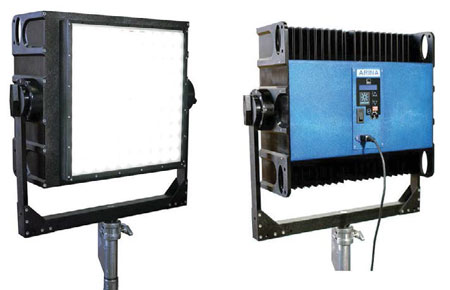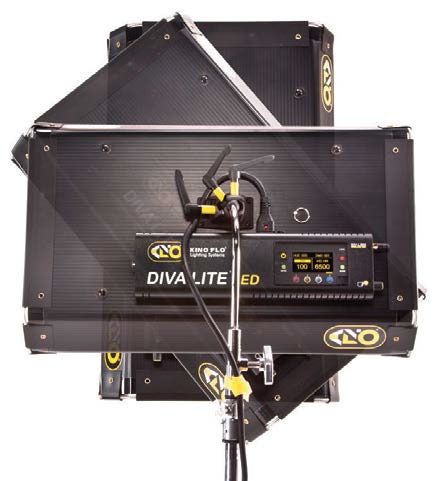LEDs Light the Way at the NAB Show
It’s safe to say that this year’s NAB Show gave us an evolution, not revolution in terms of lighting. In fact, while I was off the main floor teaching production workshops for much of the show, the overall consensus seemed to be exactly that ... an evolution.

NILA Arina fixtureCREATING SOFT SINGLE SOURCE
The big story was and still is LED lighting. The technology just keeps getting better (even though there is still a lot of junky stuff out there), and there were some interesting light fixtures to consider. The trend is definitely moving away from multiple, visible, LED diodes and moving towards creating fixtures that produce a soft, single source of light. This is usually done with diffusion panels.
I am also starting to see more lensed professional LED solutions (creating single source hard light), but I’m still waiting for something that can compete with the quality of light that an HMI can produce. I like what Fiilex, Mole Richardson and Zylight are doing but there’s still something about a K5600 Joker-Bug that LEDs can’t replicate. It might take a technology like plasma (and fixtures like HIVE’s Plasma 1000), to give HMI a run for its money but we’ll have to see how that plays out.
In the meantime, what was on the floor that caught my eye when I did have time to make the rounds?
In terms of LED lighting, one of the most impressive fixtures on display was the current versions of ARRI’s SkyPanels. The color-tunable S-30C and S-60C utilize RGB & A LEDs and along with Firmware 2.0 they can do some pretty impressive things. The one that stood out the most to me was the Rosco/Lee Gel libraries. Now you can dial in specific gels, color corrections, party colors and even emulate a traditional tungsten fixture as it would react if dimmed down. Very cool!
Both BB&S and Cineo are known for their remote phosphor lighting fixtures. I have personally used the BB&S Area 48 and pretty much the entire Cineo line (Matchbox, Maverick, HS and HS2), on many productions. I love the way they produce a wide, soft light source that is color accurate and ideal for today’s high resolution shoots. This year BB&S were featuring their Pipeline fixtures which are tube-based remote phosphor LEDs that I can see being rigged all over sets.
Cineo had a new fixture, the HSX, which is a slight departure for the company. While it shares the form factor and output of their remote phosphor HS units, the HSX is a more traditional LED-based fixture with a separate diffusion panel. It has the same form factor and output as their HS2 but is color tunable.
The professional video industry's #1 source for news, trends and product and tech information. Sign up below.
Another company I’m hearing more about is Photon Beard. They’ve been in the lighting game for a long time and seem very serious about their foray into the LED/Remote Phosphor space, as evidenced by the introduction of their Highlight LED, designed to replicate the functionality of its Highlight Fluorescent luminaires. The lights are designed to throw light from the grid typically 12 to 15 feet to the set or talent and are known for their consistent, predictable behavior, high efficiency, wide range of available sizes and full range of accessories. The LED version features all these attributes and in addition, increase efficiency and remove the need for periodic lamp replacement.
While historically Kino Flo changed the lighting game with their fluorescent fixtures, they have been in the LED game for a long time. The Celeb line was one of the first large-panel, single soft-source LEDs on the market.

Kino Flo Diva Lite LED They have now expanded their LED offerings considerably with their Diva-Lite LED and Select LEDs. It’s great to see what is arguably the most popular interview light in the world (Diva-Lite), as an LED option.
Another company strongly in the LED camp is LitePanels, which has evolved their products over the past couple of years. I am seeing a lot of bi-color Astra lights on set and they have recently released a “soft” version of that light that has a permanent diffusion panel as a part of the light. The Bluetooth option for the Astra lights is also very useful when using multiple fixtures. You can easily control them all with an app.
If you need an LED with huge output, you might want to check out the NILA Arina fixture. I tested it out in the floor and that sucker is bright but only draws 800W. It’s a monster of a light!
I also really like how the Westcott Flex Lights are evolving. Water resistant, flat packable and now available in bi-color units, I use the 1x1 and 1x2 on almost every production. There’s nothing quite like being able to gaff tape a light fixture to a ceiling or a wall.
LIGHT QUALITY & RATINGS
I like that we are moving away from just stating the CRI values of lights as a rating for quality. It’s great for some fixtures but not for others. TLCI results along with individual R values are oftentimes being published by manufacturers and that’s a good thing.
Having a good Spectrometer nowadays can be very helpful with reading the spectral data of newer lighting technologies. Traditional color meters don’t have the sensors to read them accurately.
Also look for high values in the R9 column when looking at color rendering values. That, along with other 90+ values can contribute a lot to how well skin tones will be rendered.
SPECIAL MENTION
Speaking of light and color, a recent Kickstarter campaign was successfully funded for a new line of LEDs that are as close to revolutionary as I personally know about this year.
The lights are called SoftPanels LED lights and they have a color meter built in. This basically allows the fixture to color match the environment. I don’t see the lights as a gimmick as the designers have been at this lighting game since professional LEDs have been introduced into the industry. Once they come to market I look forward to taking them for a spin.
Jem Schofield is the founder of “theC47,” an online and offline educational resource focused on teaching the craft of video production and filmmaking. He is a producer, DP, director and educator and also runs The Filmmaker’s Intensive, a program that focuses on teaching the art and science of documentary and narrative filmmaking. For more about Jem and his whereabouts visittheC47.com.
